 When I was a girl, I read countless old books. These brittle volumes usually smelled of crumbling book glue and dust; some left a sprinkling of yellowed page edges on my lap as I turned each leaf. I read and re-read my old books until they, quite literally, fell apart. But in all my reading, I never cared much for the stories about perfect, quiet girls, who had little more to offer than exquisite conversation skills and needlework. I wanted to — and did! — read about the spunky outliers; I loved the books about fearless girls who dove, often, into the unexpected.
When I was a girl, I read countless old books. These brittle volumes usually smelled of crumbling book glue and dust; some left a sprinkling of yellowed page edges on my lap as I turned each leaf. I read and re-read my old books until they, quite literally, fell apart. But in all my reading, I never cared much for the stories about perfect, quiet girls, who had little more to offer than exquisite conversation skills and needlework. I wanted to — and did! — read about the spunky outliers; I loved the books about fearless girls who dove, often, into the unexpected.
[Disclosure of Material Connection: I received two titles from the Aunt Claire Presents series in exchange for reviewing this product and publishing this post, and I was also compensated for my time.]
[We are a participant in the Amazon Services LLC Associates Program, an affiliate advertising program designed to provide a means for us to earn fees by linking to Amazon.com and affiliated sites.
As an Amazon Associate I earn from qualifying purchases.]
And I wasn’t interested in the idea of life having been more wholesome long ago. (Human nature, after all, has always been human nature.) I was far more fascinated by the degree to which people have stayed the same, despite obvious changes in culture, manners, fashion, and technology.
As a voracious bookworm, I never considered all the vintage books I read as school, per se. Yet looking back, there’s a whole world of knowledge I gleaned from reading old books. (Yes, even the fiction titles!)
Using Vintage Fiction Books to Challenge Gifted / Accelerated Readers
If you are familiar with our story at all, you know books are a huge part of our everyday. Aside from having been a mini bookwork myself, I’m now raising a mini bookworm — a kiddo who hasn’t yet turned seven, but read 561 books in 2016, and has read 450 books so far in 2017. Talk about trying to keep her in age-appropriate reading material!
If you have a gifted child or an accelerated reader, you know firsthand just how difficult that is. Although I wholeheartedly believe kids truly can handle a lot of unabridged classics, there has to be room for escaping into light, fun adventure novels, too. (After all, how often do adults actually read books at the true upper end of their reading comprehension level?) But with so much of the middle-grade fiction published today full of themes entirely inappropriate for a sensitive six-year-old, books for an accelerated reader can be incredibly hard to find.
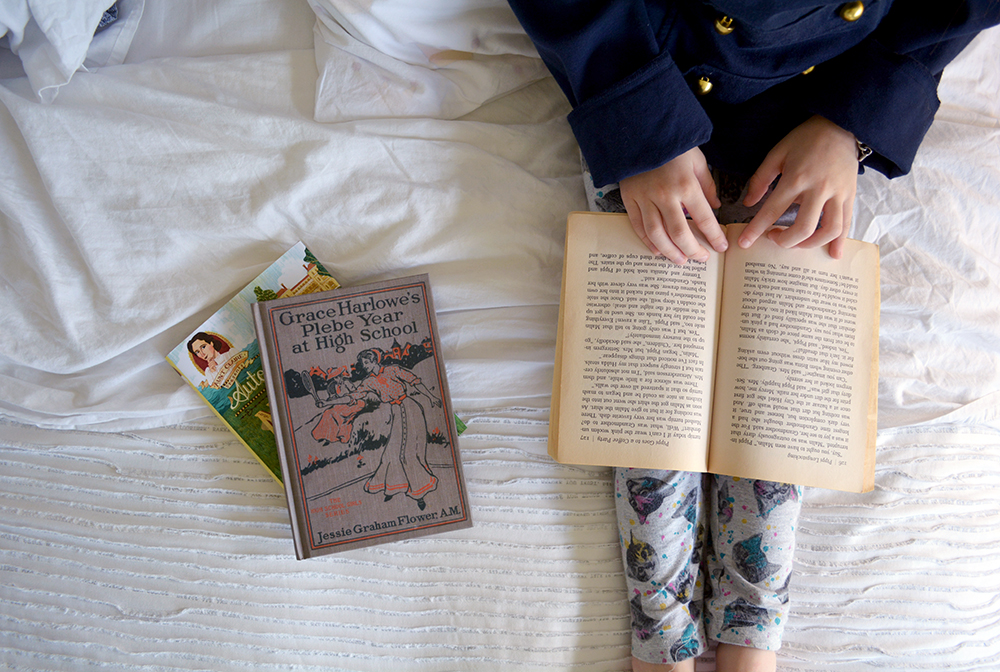
Introducing Aunt Claire Presents, Published by Laboratory Books
I’m so thankful for throwback chapter books, like these 1910 novels re-released under the series name Aunt Claire Presents, Published by Laboratory Books. These books are big on adventure, but nil on romance — so perfect for my tiny, voracious reader. I recently had the pleasure of reading the first books they’ve released, The Automobile Girls at Newport by Laura Dent Crane and Grace Harlowe’s Freshman Year at High School by Jessie Graham Flower, A.M. Except for the brilliantly-written introductions, which offer some historical context and cultural background for the stories, the text of the books remains unchanged from the original editions. (And the original cover is hidden under the modern dust-jacket, too!)
These are definitely books about mighty girls — they’re educated, independent, meet with detectives, and act as their own chauffeurs and mechanics. (Can you picture the girls in their Gibson Girl pastels, driving at break-neck speed along a dusty road? So fascinating!) Written just as the Gilded Age was transitioning into the Progressive Age, these books have powerful undercurrents of the suffragette movement, and weave themes of empowerment naturally into the story lines.
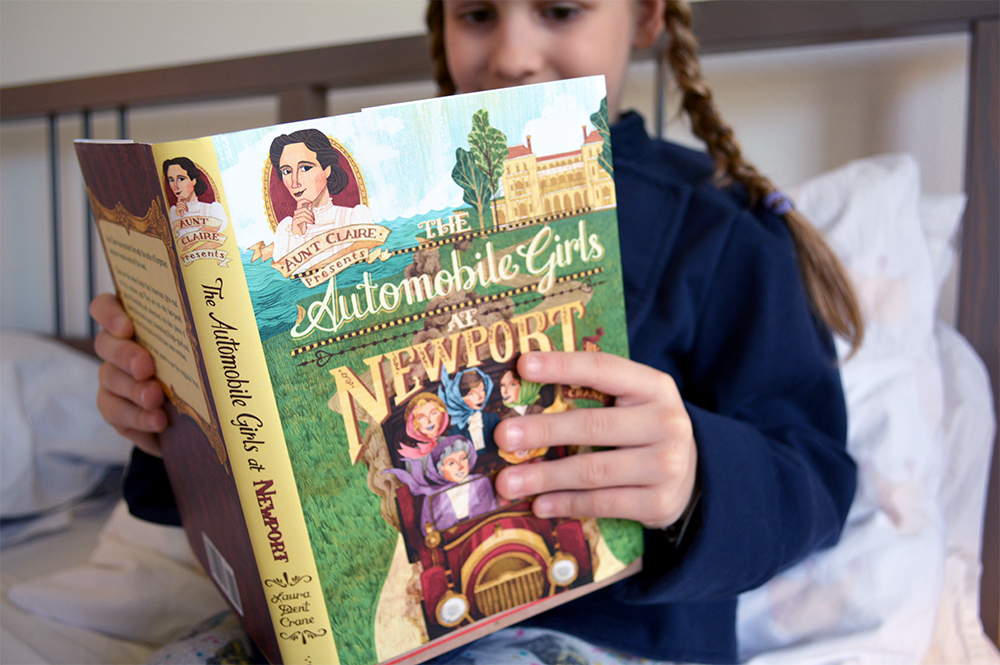
These are adventure stories; there’s no doubt about that. The plot twists range from homework and road trips to burglaries, kidnappings, jewel thieves, and even hungry wolves. They have a playful flavor, too, with the occasional foray into spooky Victorian parlor games and Halloween mischief. My favorite part? Reading the Aunt Claire Presents series is an immersive experience in early 1900s life. I love how each book is overflowing with real-life examples of the music, clothing, books, and architecture which made this era so extraordinary. These are ideal books to integrate into your homeschool lessons, since they show a real microcosm of life at the turn of the century.
And did you know? Historical books can be used to teach more than just history. I especially enjoy using old books to teach literature-based geography.
Download a FREE Geography Supplement for The Automobile Girls at Newport
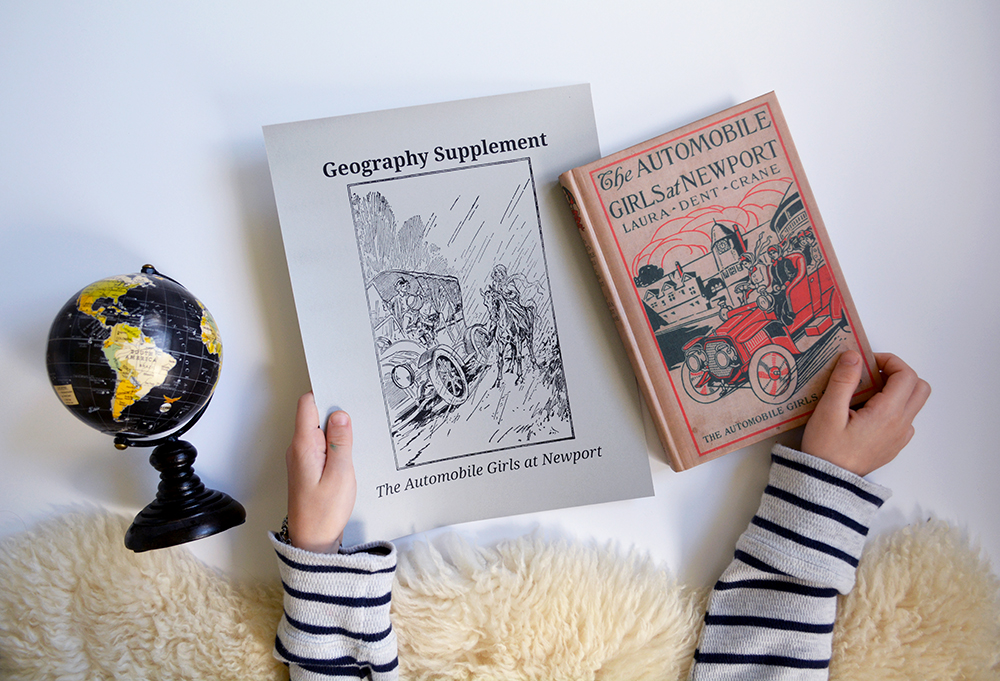
While it’s true not all titles lend themselves to teaching geography well, there are more ways to extract geography from books than you’d think. The Automobile Girls at Newport, though, happens to be perfectly suited for geography exploration. The book’s plot centers around a road trip from New Jersey through Yale to Rhode Island, and author mentions a plethora of actual historical locations by name. To spur further research, I’ve listed several of these in a FREE printable PDF supplement, and included links to photos, both modern day and historic.
This printable also includes the page number where the location is first mentioned, so you can easily find the context. The activities I’ve included are only suggested starting points. You can use the locations as research prompts for independent or directed learning, and enjoy exploring your local library or reputable websites for additional information. There’s so much potential here for any entire geography unit of the Eastern Seaboard!
Click to download the FREE Geography Supplement for The Automobile Girls at Newport
Using Vintage Fiction Books to Teach Geography
Even when vintage books are set in entirely fictional locations, as with Grace Harlowe’s Freshman Year at High School, readers can infer information about the climate, landforms, and physical geography by using context clues in the story.
Now there’s a fun writing assignment — making the case for the kind of place in which a given fiction book is set. Astute readers can scour the pages for hints.
- Does the author mention inland bodies of water, or oceans?
- Do the characters see mountains?
- Are prairies or grassy fields mentioned in the story?
- Are any plants, flowers, or trees mentioned by name?
- If so, what type of climate might support these types of foliage?
- At what time of year is the story set?
- What does the weather seem to be like?
A well-written book, fiction or otherwise, leaves the reader with a distinct sense of the setting. (These are cues kids can take, too, when creating the setting for their own creative writing ventures or short stories.)
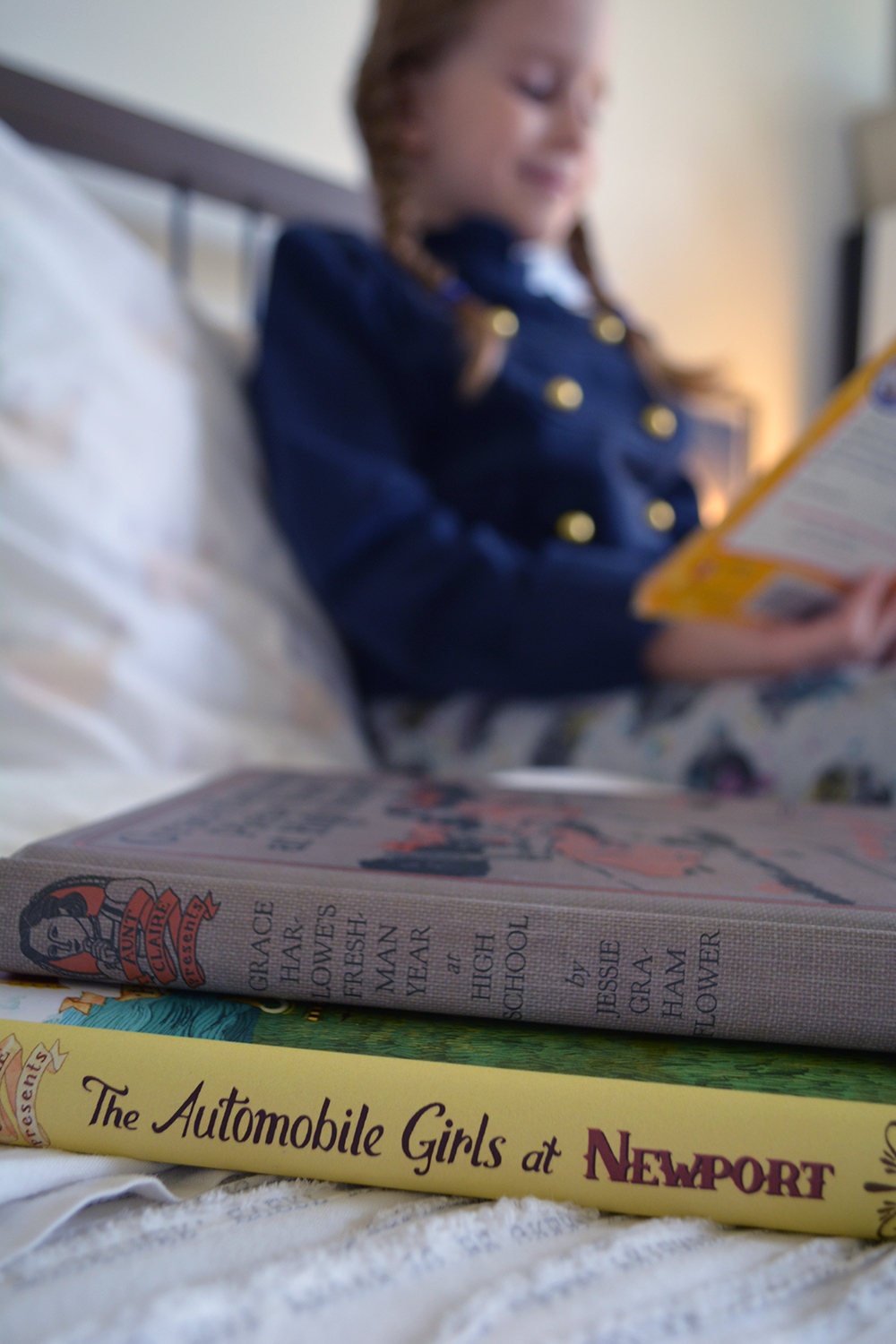
Using Vintage Fiction Books to Teach Music
One of the delightful aspects of old books is how they retain the flavor of the era in which they were written. And this doesn’t end at visual descriptions. I love uncovering what the world of vintage books must have sounded like, beyond the hum of dialogue or the clickety-clack of a train.
In Grace Harlowe’s Freshman Year at High School, for instance, the characters perform a play while the Funeral March of a Marionette plays. That’s a whole research-rich rabbit trail right there!
- What does The Funeral March of a Marionette sound like with full orchestra?
- What about just piano?
- When was it written?
- Who was the composer?
- How old would this song have been at the time the book was written?
- Was the piece of music originally written a parody, or was it composed in a serious context?
- Why do you think it was sometimes later chosen by film and television directors for spooky scenes?
- Do you agree that the song sounds spooky?
- Can you get piano sheet music for Funeral March of a Marionette, and learn to play it?
And that’s only one song! There are several more songs mentioned in The Automobile Girls at Newport, too. When you learn to pay attention to the songs and music mentioned in old books, a whole world will open up.
Using Vintage Fiction Books to Teach Nuances About History
The narrative, immersive nature of living books offers historical insight textbooks simply cannot. When we learn history from a textbook, we’re told that the Gilded Age ended in 1900. While this is technically true, if we — like the Automobile Girls — were living at the turn of the century, we wouldn’t know that yet. The living, breathing reality is that the end of one era faded naturally and unobtrusively into the birth of another, with amorphous blending and intermingling of each era’s greatest characteristics. No woman stepped out of bed on New Year’s Day 1900, and scrubbed her life clean of any trappings of the Gilded Age. Life went on.
As the Automobile Girls’ adventures demonstrate, the towering edifices on Bellevue Avenue — home of John Jacob Astor and the Vanderbilts — did not crumble at the stroke of midnight on New Year’s Eve 1899. Many people continued to bustle about in excess, unaware the days of the railroad tycoons were growing smaller in the rear-view mirror, and unaware just how significant the cultural impact of the dawning Progressive Age would prove to be.
Living books show us that for those living inside history — just as we live inside history now — the ages march on, unnamed and unknown.
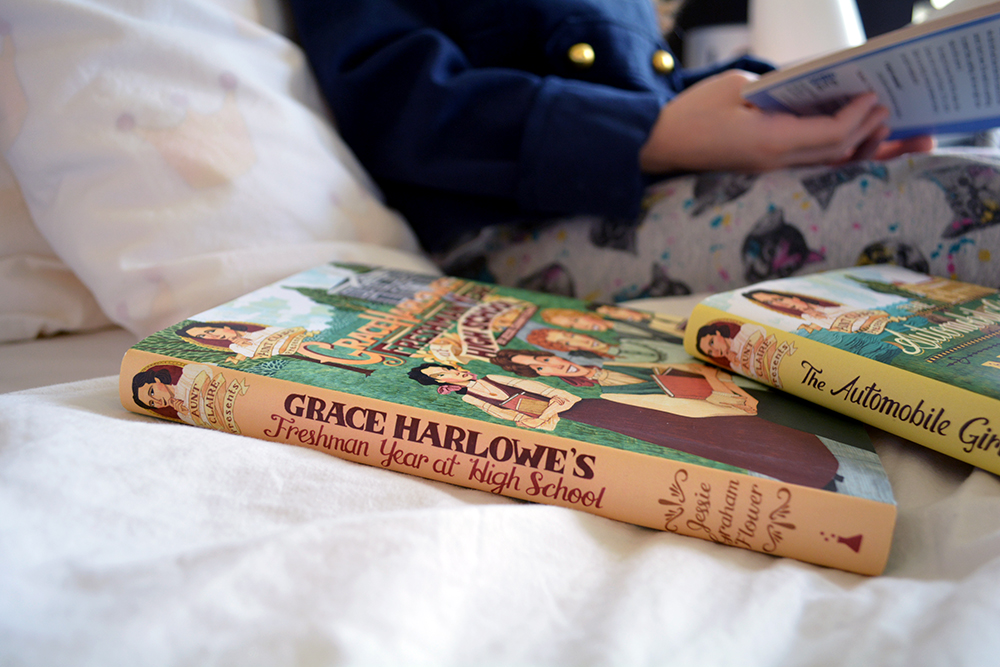
Using Vintage Fiction Books to Encourage Annotation and Close Reading to Uncover Historical Clues
Encourage your young readers to annotate the book as they read! Annotation is such a great skill to develop. Allow them to mark directly on the book pages — a fine-point mechanical pencil is perfect for this. Help your child develop a personalized system for annotation — asterisks next to unknown vocabulary, brackets around phrases or topics they’d like to look up later, etc. You can learn so much about a book’s historical and cultural context by diving into what the characters are talking about. Pay attention to topics such as —
- What books are the characters reading?
- What foods do they eat? Are these the same foods you eat?
- Do they talk about clothing unfamiliar to you?
- What music do they talk about, sing, or play?
- What holidays do they celebrate?
- What aspects of life seem normal to the characters, but strike you as odd?
- Do the characters talk about or mention any names of people who aren’t characters in the book? Use these names as clues to research!
For instance, in the Automobile Girls, one of the girls says, “You did look…like a sort of desperate, feminine Darius Green with his flying machine!” Unless you’re annotating, you’d probably skip right over the mention of Darius Green. But if you’re working on your close reading detective skills, you’d underline the name, wonder who he was, and look it up. With a little research, you’d discover a narrative poem called “Darius Green and His Flying-Machine”, published in in 1867. And then, you’d see Houghton-Mifflin re-released it again in 1910, and you’d remember the Automobile Girls was originally released in 1910, too. You can even read the 1910 version of Darius Green and his Flying-Machine!
Close reading is such a great opportunity to share a literary experience with the book characters themselves. Developing your investigative reading skills opens up a huge, undiscovered world inside the already-rich world of books.
Download FREE Printable Vocabulary Supplement for The Automobile Girls at Newport
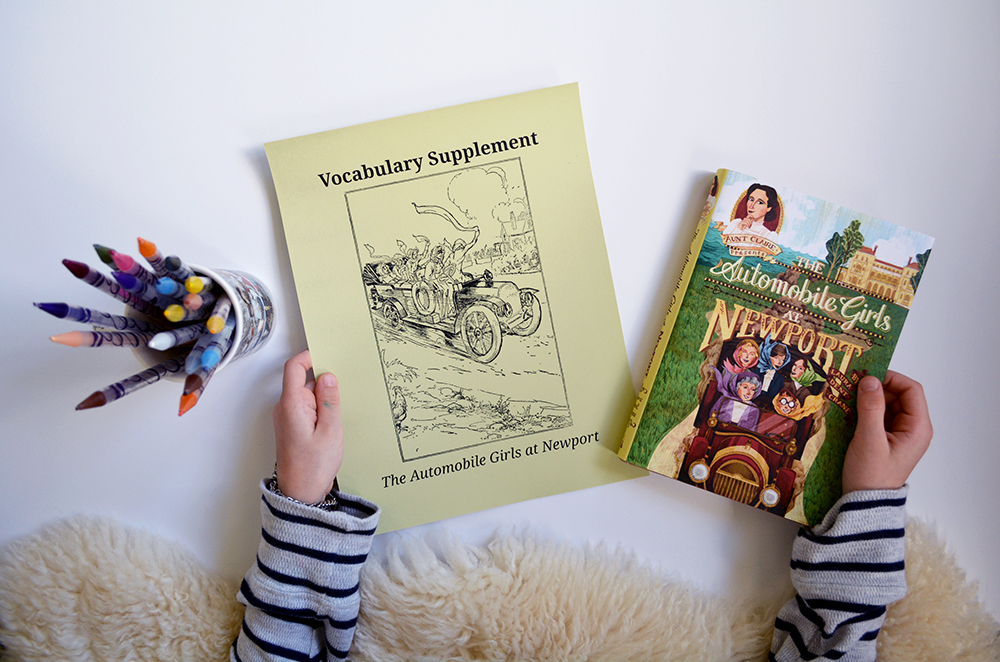
Apart from technology, the passage of time is perhaps nowhere more evident than in the evolution of language. Dialogue-rich stories such as the ones reprinted by Aunt Claire Presents offer us the unique opportunity to hear the exclamations, idioms, and turns of phrases en vogue over hundred years ago. But beyond the historical vocabulary, there are also dozens and dozens of relevant bits of vocabulary worth studying. Don’t buy into the myth that old books can only teach you old words; that’s simply not true. I’ve created a FREE downloadable PDF containing all the notable vocabulary words in The Automobile Girls at Newport. I’ve defined — or given a synonym for — each word, and showed the context as it appeared in the book. And, I’ve organized the printable supplement by chapter, too, making it an easy-to-use reference tool. As your child annotates unfamiliar words in the book, he or she can use the vocabulary supplement to look up those words.
Click to download the FREE Vocabulary Supplement for The Automobile Girls at Newport
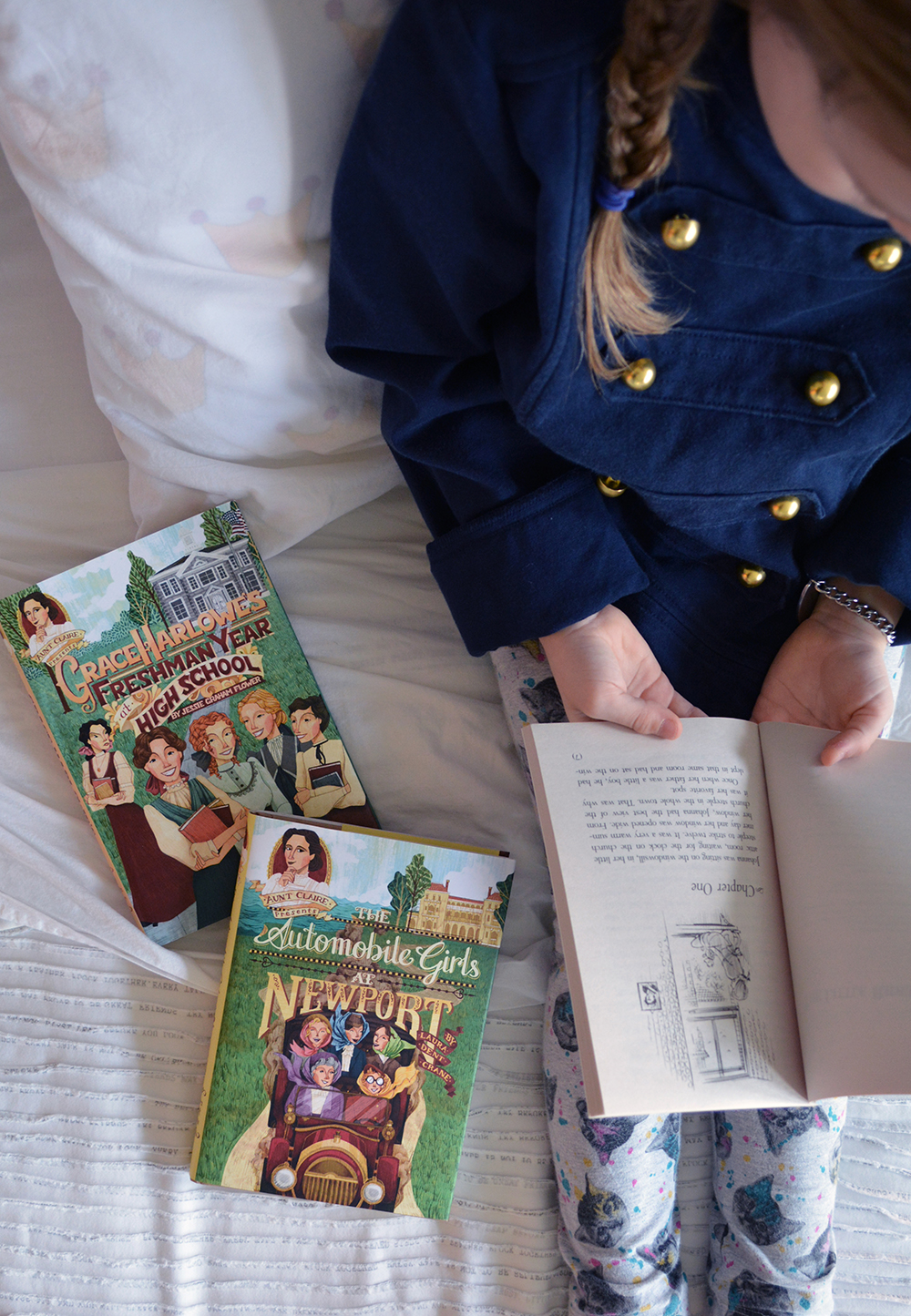
Using Vintage Fiction Books to Enrich Homeschool Lessons
While I don’t advocate pummeling the life out of reading for pleasure by requiring kids to do homework based on the books they’ve read during free time, I do believe you can intentionally assign fun books as schoolwork. After all, there shouldn’t be a required-reading/free-reading dichotomy. Books which are enjoyable to read should appear in both categories, and these books are a perfect example. Truly considering using the fun-to-read Aunt Claire Presents series in a unit about life in American in 1910!
- The Automobile Girls at Newport by Laura Dent Crane
- Grace Harlowe’s Freshman Year at High School by Jessie Graham Flower, A.M.
And there are two more titles coming out in the spring, too.
- The Girl Aviators and the Phantom Airship by Margaret Burnham
- Grace Harlowe’s Sophomore Year at High School by Jessie Graham Flower, A.M.
I can’t wait to read about the girl aviators! Be sure to follow @auntclairepresents and @laboratory_books on Instagram, so you don’t miss the releases in Spring 2018.
How about you? Have you ever considering using fictional books in your lessons? How have you integrated adventure stories or vintage stories into your homeschool days?
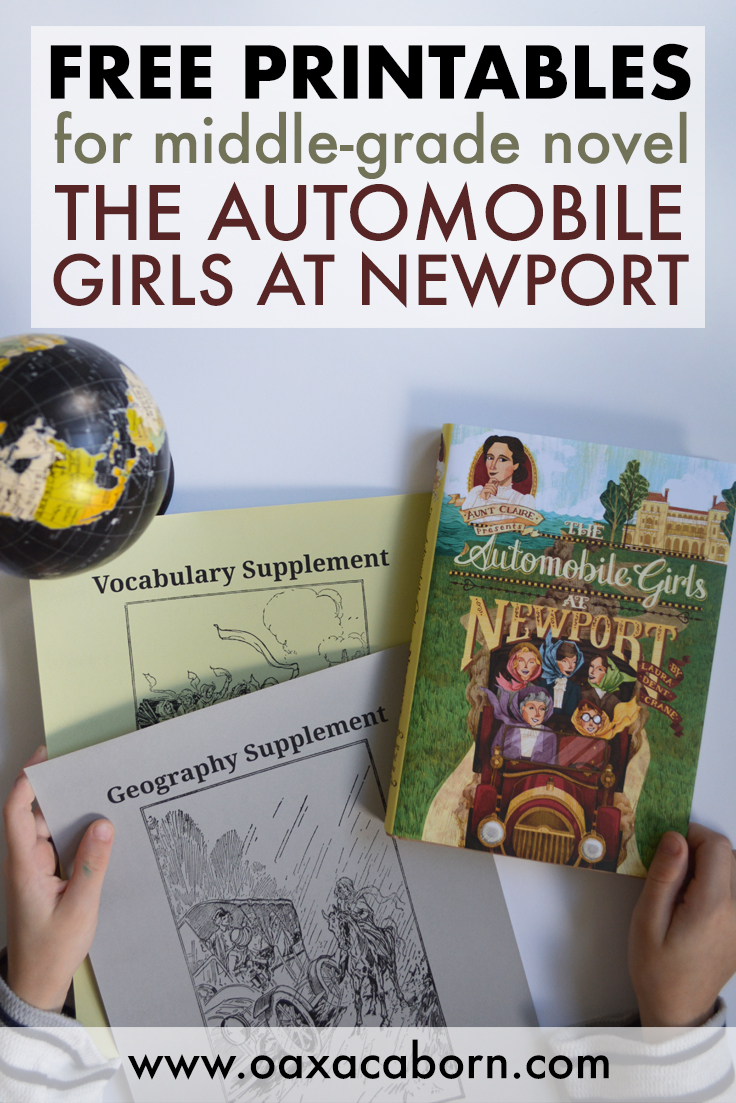
—
Disclosure of Material Connection:: I received two titles from the Aunt Claire Presents series in exchange for reviewing this product and publishing this post, and I was also compensated for my time. All the photographs, opinions, and experiences shared here are in my own words and are my own honest evaluation. I was not required to write a positive review.
—
We are a participant in the Amazon Services LLC Associates Program, an affiliate advertising program designed to provide a means for us to earn fees by linking to Amazon.com and affiliated sites.
—




I do use fiction books to teach history, geography, and even science at times but I really related to how tough it is to find age appropriate books for voracious readers. My 11 year old reads ALL the time and most young adult fiction deals with concepts he’s not ready to read about. It’s hard finding “clean” books that are exciting and really grab his attention.
LikeLiked by 1 person
Yes! It’s such a challenge to keep up.
LikeLike
We really enjoyed these books, too! Thanks for sharing the supplementals. Great resources!
I’m so glad you linked up with the Homeschool Blog and Tell. You’re the featured post this week!
LikeLike